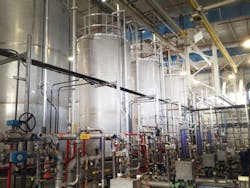About the author: Andrew Anderson is eastern U.S. water, wastewater and infrastructure manager for Victaulic. Anderson can be reached at [email protected] or 803.360.7727.
Jamaica Bay is a 28,000-acre estuary in New York City that is considered to be one of the city’s most diverse natural habitats due to its vast open waters, salt marshes, woodlands and freshwater wetlands. Throughout recent decades, the water quality at Jamaica Bay has deteriorated considerably, a rapid decline that is attributed to an overabundance of nitrogen in wastewater discharge from the city’s treatment plants.
Nitrogen in the atmosphere is essential to human existence and poses no health threat. However, excess nitrogen in water can be harmful to aquatic ecosystems, particularly during summer months. In excess, nitrogen leads to a significant decrease in oxygen available to aquatic life, known as hypoxia, which ultimately causes a reduction in biodiversity due to an overabundance of algae. The resulting aquatic “dead zones” reduce available nutrients in the bay, making it difficult for the New York City Department of Environmental Protection (DEP), the government entity charged with managing the city’s water supply, to meet critical water treatment regulatory requirements on reducing discharge of nitrogen.
To alleviate this issue, DEP launched a comprehensive campaign to upgrade the water quality at Jamaica Bay by reducing the level of nitrogen in its waters. DEP put the project out to bid by various contractors before deciding on WDF Inc., a New York-based HVAC, mechanical and plumbing contractor, that, in coordination with engineering firms CH2M Hill and Hazen and Sawyer, presented a design to develop a separate centrate treatment (SCT) wastewater facility. In this system, the SCT process, using glycerol as a stimulus, converts nitrogen in the water to harmless nitrogen gas that is dispelled into the air.
No More Nitrogen
In the past, researchers believed that an ammonia recovery system worked best for treating excess nitrogen levels. Methanol also is used by approximately 200 treatment plants in the U.S.; however, both options have the potential to exacerbate safety challenges, as methanol is highly toxic and flammable, and increases costs due to methanol’s price volatility. Through the development of the SCT facility, the team saved the city approximately $30 million, as glycerol is readily available and more cost effective.
CH2M Hill and Hazen and Sawyer had Victaulic products in mind from design conception. Hazen and Sawyer and CH2M Hill knew of Victaulic’s products, and the safety and speed of installation associated with grooved products. In the final design, Hazen and Sawyer planned to use Style 489 stainless couplings, stainless steel elbows and reducers, and the Vic-Press system for the glycerol piping.
Kevin Beirne, water and wastewater sales specialist, oversaw the project for Victaulic, providing guidance, onsite training and immediate support at all stages of the project.
Hazen and Sawyer and CH2M Hill chose to use 316 stainless steel piping, a high-quality, pure type of stainless steel, to pump glycerol into effluent before it is dispelled into the bay. Due to the greater risk of contamination when welding high grades of stainless steel, the use of couplings was necessary. With costs accumulating each day, the high levels of nitrogen continued to exist, and the Vic-Press hand-held tool provided quick and flexible installation.
“The DEP was looking to our customer, WDF Inc., to provide a quick and reliable solution to help them meet strict job-site regulations,” Beirne said. “Welding would have taken significantly longer and would have put employees at risk. Our products provided the perfect solution to these potential problems.”
Moving Forward
The SCT wastewater facility is the first of its kind on a global scale. By replacing nitrogen with glycerol, which is nonhazardous and nonflammable, the systems have successfully reduced the nitrogen discharges by approximately 67%.
The SCT wastewater facility is currently being tested on the effluent phase of five wastewater facilities—Jamaica Bay, 26th Ward, Wards Island, Bowery Bay and Tallman Island. In other parts of the country, municipalities must comply with more stringent wastewater requirements with regard to nitrogen discharge. Through this project, use of the technology demonstrated that achieving nitrogen removal wastewater goals is feasible and affordable. These methods can also be applied to bodies of water that are currently lacking oxygen, including Chesapeake Bay and the Gulf of Mexico.
This step toward sustainable and effectual wastewater treatment has received global recognition in engineering excellence. In 2013, this use of technology earned the team the American Council of Engineering Companies of New York’s Empire Award. Throughout the world, as regulations become more stringent and nutrients become ever scarcer, treatment technology has the potential to transform the way that wastewater is processed and, in turn, protect the valuable diversity of aquatic ecosystems worldwide.
